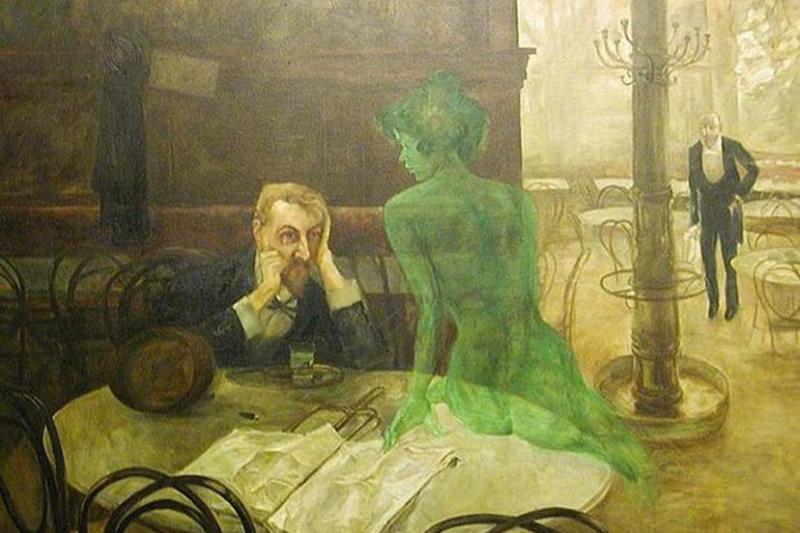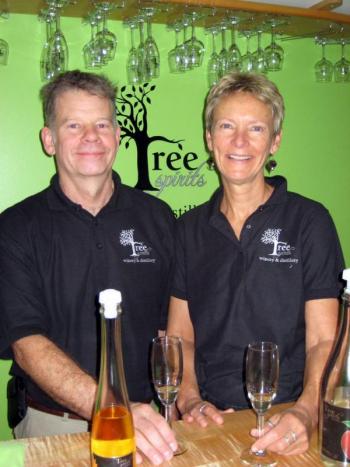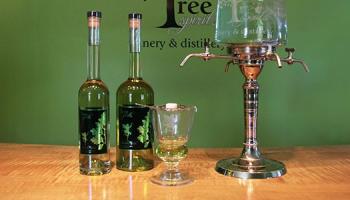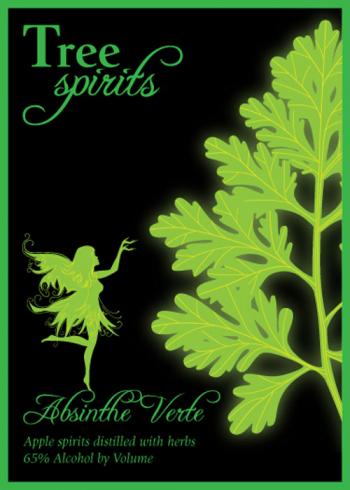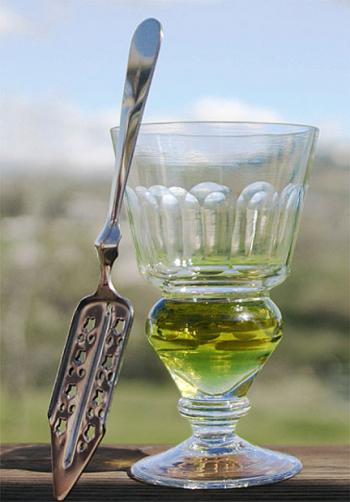OAKLAND — Ernest Hemingway used to sit around at a bar, downing multiple cocktails made from the spirit absinthe, prompting the cocktail to be called Death In The Afternoon, after his novel by the same name.
Out of every alcoholic spirit on the shelf, absinthe is probably the least understood and most mysterious beverage—and it’s making a comeback in Maine.
Bruce Olson, founder and owner of Tree Spirits of Maine, in Oakland, is the first distillery in this state to receive federal approval to make and sell absinthe since the U.S. ban on it was lifted in 2007. His original creation, called Absinthe Verte, draws from a recipe from the 1800s, using his unaged applejack. It is re-distilled with grand wormwood, fennel and anise, then colored with an infusion of petite wormwood, lemon balm and hyssop.
Absinthe originated in Switzerland and became a favorite of the working-class French and artists, particularly the bohemian set. Originally made with a grape-based spirit, like a cognac, a change in the way absinthe was produced began to be known as “the poor man’s drink,” said Olson. “I believe the reason it became a more affordable drink in the 1800s is because they switched to a cheaper source of sugar, which was I think, beet sugar. Most absinthe is now made with neutral spirits. Everyone was looking for the cheapest distilled spirit.”
Every day around 5 p.m., bars, bistros and cafes called their happy hour l'heure verte ("the green hour") after absinthe’s noticeably green-tinged color. With the addition of botanical ingredients, such as green anise, fennel and other herbs, it was nicknamed “The Green Fairy.” The most important ingredient, grand wormwood, contained the chemical compound thujone, which was widely believed to cause the drinker to fall into a hallucinogenic state.
“Absinthe was huge in the late 1800s at a time known as La Belle Époque,” said Olson. “Because it was cheaper than wine at the time, it became a drink of the working class as well as the bohemians. That didn't make the wine makers happy.” The final straw was when a Swiss farmer killed his entire family after drinking gallons of liquor and wine, topping it all off with a drink of absinthe. The Swiss government banned the spirit from being made or sold in 1910. This prompted the U.S. to ban it in 1912. France, considered the biggest producer of absinthe, then banned it in 1915, with other parts of western Europe following suit.
It’s not widely understood why, after almost a century of being banned, that absinthe is once again, legal to produce and distribute in the United States. The Wormwood Society suggests that it’s because federal agencies have determined a specific method to analyze levels of thujone is now available. In this case, it’s only a trace amount. Not that anyone will necessarily notice. For many years, the makers of absinthe simply eliminated the wormwood, making a substitute product.
Olson said, “One of the original and biggest producers of absinthe in the world is the company Pernod, named after founder Henri-Louis Pernod, which still calls its absinthe brand Pernod,” he said. “When absinthe was outlawed, they basically just took the wormwood out of the formula and produced a similar product.”
When you look at Olson’s label, the ironic part of that federal requirement is that it features a shimmering fairy next to the wormwood plant. “They approved our first label, which surprised us,” he said. “But given the fact that absinthe has been known for more than a century as ‘The Green Fairy,’ the federal agency perhaps thought a green fairy on the label was apropos. And the fluorescent green on the label doesn’t show it, but it’s sort of hazy around the wormwood leaves. We didn't think they were going to like that. It turned out after talking with them, that they were most concerned that it would be attractive to underage drinkers, but the price was high enough that wasn't going to happen.”
When Olson began looking for the herbs needed to construct absinthe, he couldn’t find any in Maine so he had to source it from an organic farm in Oregon. “But it’s interesting,” he said. “Since people have learned we’re making absinthe, we’ve gotten calls from Maine farmers who have what we need so we’re hoping this summer we’ll have locally sourced herbs for it.”
Since his product’s debut in April, it’s been very popular. “We make small batches at a time and each time, they sell out,” he said.
It’s not exactly the poor man’s drink anymore though, as each bottle sells for $57 for 375 milliliters and $77 for the 750-milliliter bottle.
He said the best way to serve the unique spirit is to put an ounce of absinthe into a glass with a slotted spoon across the rim. Then put a sugar cube on the spoon and drip ice water over the sugar cube, which drains into the glass. The goal is to dilute the drink to 4 ounces of water per 1 ounce of absinthe.
Olson said they distribute Absinthe Verte through Pine Street Spirits, and it can be specially ordered at small agency stores if not already carried.
To try a Death In The Afternoon this New Year’s Eve, here is the recipe:
- A shaker of ice, in which you pour:
- Juice from ¼ of a lemon
- ¾ ounce of absinthe
- A splash of Cointreau
- Shake and strain into a champagne flute
- Top with Cava or any sparkling wine (or champagne) and garnish with a lemon twist.
Watch Penobscot Bay Pilot’s “What’s In That Cocktail” video.
To learn more about Absinthe Verte, visit Tree Spirits of Maine
Kay Stephens can be reached at news@penbaypilot.com


